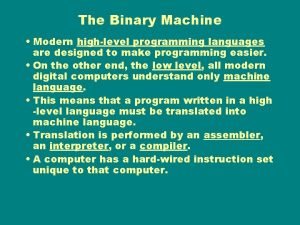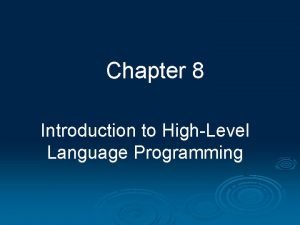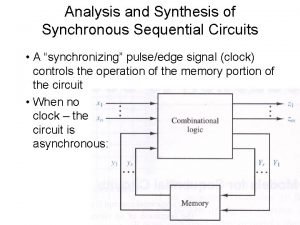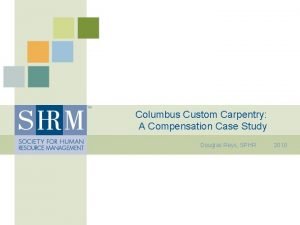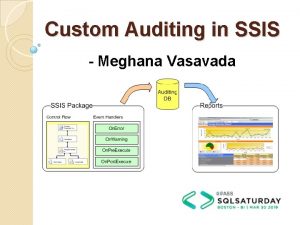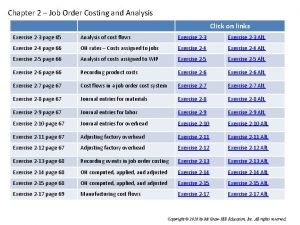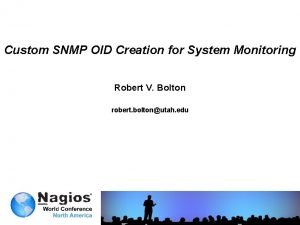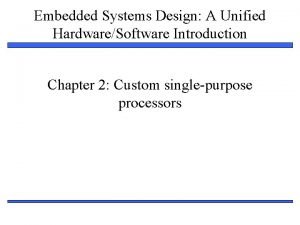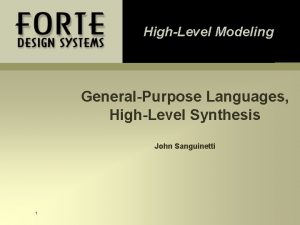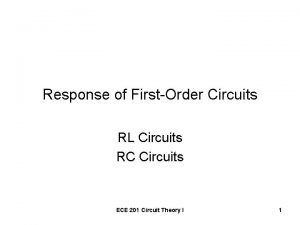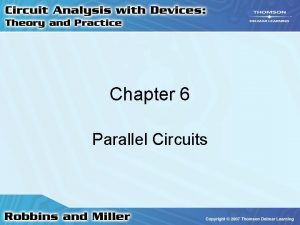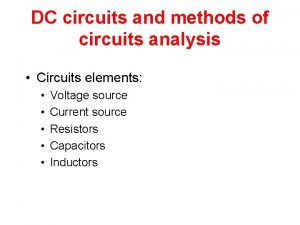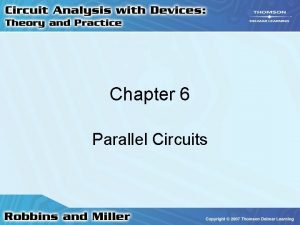HighLevel Synthesis Creating Custom Circuits from HighLevel Code
















![High-Level Synthesis acc = 0; for (i=0; i < 128; i++) acc += a[i]; High-Level Synthesis acc = 0; for (i=0; i < 128; i++) acc += a[i];](https://slidetodoc.com/presentation_image/28879257d119e6dc738ddcda9e65538d/image-17.jpg)







































































- Slides: 88

High-Level Synthesis: Creating Custom Circuits from High-Level Code Greg Stitt ECE Department University of Florida

Existing FPGA Tool Flow n Register-transfer (RT) synthesis n Specify RT structure (muxes, registers, etc) + Allows precise specification n - But, time consuming, difficult, error prone n HDL RT Synthesis Netlist Technology Mapping Physical Design Placement Bitfile Routing FPGA Processor

Future FPGA Tool Flow? C/C++, Java, etc. High-level Synthesis HDL RT Synthesis Netlist Technology Mapping Physical Design Placement Bitfile Routing FPGA Processor

High-level Synthesis n Wouldn’t it be nice to write high-level code? n n n Ratio of C to VHDL developers (10000: 1 ? ) + Easier to specify + Separates function from architecture n n + More portable - Hardware potentially slower n Similar to assembly code era n n n Programmers could always beat compiler But, no longer the case Hopefully, high-level synthesis will catch up to manual effort

High-level Synthesis n More challenging than compilation n Compilation maps behavior into assembly instructions n n Architecture is known to compiler High-level synthesis creates a custom architecture to execute behavior n n n Huge hardware exploration space Best solution may include microprocessors Should handle any high-level code n Not all code appropriate for hardware

High-level Synthesis n First, consider how to manually convert high-level code into circuit acc = 0; for (i=0; i < 128; i++) acc += a[i]; n Steps n n 1) Build FSM for controller 2) Build datapath based on FSM

Manual Example n Build a FSM (controller) n Decompose code into states acc = 0; for (i=0; i < 128; i++) acc += a[i]; acc=0, i = 0 if (i < 128) load a[i] acc += a[i] i++ Done

Manual Example n Build a datapath n Allocate resources for each state acc=0, i = 0 if (i < 128) load a[i] 1 acc += a[i] acc i Done 128 + < i++ acc = 0; for (i=0; i < 128; i++) acc += a[i]; addr 1 + +

Manual Example n Build a datapath n acc=0, i = 0 0 if (i < 128) load a[i] Done 1 acc += a[i] In from memory Determine register inputs &a 0 2 x 1 i acc 2 x 1 a[i] 128 + < i++ acc = 0; for (i=0; i < 128; i++) acc += a[i]; addr 1 + +

Manual Example n Build a datapath n In from memory Add outputs acc=0, i = 0 if (i < 128) load a[i] Done 1 acc += a[i] 0 0 2 x 1 i acc &a 2 x 1 a[i] 128 + < addr 1 + + i++ acc = 0; for (i=0; i < 128; i++) acc += a[i]; acc Memory address

Manual Example n Build a datapath n In from memory Add control signals acc=0, i = 0 if (i < 128) load a[i] Done 1 acc += a[i] 0 0 2 x 1 i acc &a 2 x 1 a[i] 128 + < addr 1 + + i++ acc = 0; for (i=0; i < 128; i++) acc += a[i]; acc Memory address

Manual Example n Combine controller+datapath In from memory Controller 1 Memory Read 0 2 x 1 i acc &a 2 x 1 a[i] 128 + Done 0 < acc = 0; for (i=0; i < 128; i++) acc += a[i]; addr 1 + acc + Memory address

Manual Example n Alternatives n Use one adder (plus muxes) 0 0 2 x 1 i acc In from memory &a 2 x 1 a[i] addr 1 128 < MUX + acc Memory address

Manual Example n Comparison with high-level synthesis n Determining when to perform each operation n n Allocating resource for each operation n n => Scheduling => Resource allocation Mapping operations onto resources n => Binding

Another Example n Your turn x=0; for (i=0; i < 100; i++) { if (a[i] > 0) x ++; else x --; a[i] = x; } //output x n Steps 1) Build FSM (do not perform if conversion) n 2) Build datapath based on FSM n

High-Level Synthesis High-level Code Could be C, C++, Java, Perl, Python, System. C, Impulse. C, etc. High-Level Synthesis Custom Circuit Usually a RT VHDL description, but could as low level as a bit file
![HighLevel Synthesis acc 0 for i0 i 128 i acc ai High-Level Synthesis acc = 0; for (i=0; i < 128; i++) acc += a[i];](https://slidetodoc.com/presentation_image/28879257d119e6dc738ddcda9e65538d/image-17.jpg)
High-Level Synthesis acc = 0; for (i=0; i < 128; i++) acc += a[i]; High-Level Synthesis Controller 1 In from memory 0 0 2 x 1 i acc 2 x 1 a[i] 128 + < Done Memory Read &a + acc addr 1 + Memory address

Main Steps High-level Code Front-end Syntactic Analysis Converts code to intermediate representation - allows all following steps to use common format. Intermediate Representation Optimization Determines when each operation will execute, and resources used Scheduling/Resource Allocation Back-end Binding/Resource Sharing Maps operations onto physical resources Controller + Datapath

Syntactic Analysis n Definition: Analysis of code to verify syntactic correctness n n Converts code into intermediate representation 2 steps n n 1) Lexical analysis (Lexing) 2) Parsing High-level Code Lexical Analysis Syntactic Analysis Parsing Intermediate Representation

Lexical Analysis n Lexical analysis (lexing) breaks code into a series of defined tokens n Token: defined language constructs x = 0; if (y < z) x = 1; Lexical Analysis ID(x), ASSIGN, INT(0), SEMICOLON, IF, LPAREN, ID(y), LT, ID(z), RPAREN, ID(x), ASSIGN, INT(1), SEMICOLON

Lexing Tools n Define tokens using regular expressions - outputs C code that lexes input n Common tool is “lex” /* braces and parentheses */ "[" { YYPRINT; return LBRACE; } "]" { YYPRINT; return RBRACE; } ", " { YYPRINT; return COMMA; } "; " { YYPRINT; return SEMICOLON; } "!" { YYPRINT; return EXCLAMATION; } "{" { YYPRINT; return LBRACKET; } "}" { YYPRINT; return RBRACKET; } "-" { YYPRINT; return MINUS; } /* integers [0 -9]+ { yylval. int. Val = atoi( yytext ); return INT; }

Parsing n Analysis of token sequence to determine correct grammatical structure n Languages defined by context-free grammar Correct Programs Grammar Program = Exp = Stmt SEMICOLON | IF LPAREN Cond RPAREN Exp | Exp Cond = ID Comp ID Stmt = ID ASSIGN INT Comp = LT | NE x = 0; y = 1; if (a < b) x = 10; if (var 1 != var 2) x = 10; x = 0; if (y < z) x = 1; y = 5; t = 1;

Parsing Grammar Program = Exp = S SEMICOLON | Incorrect Programs x = 3 + 5; x = 5; ; x=5 IF LPAREN Cond RPAREN Exp | Exp Cond = ID Comp ID S = ID ASSIGN INT Comp = LT | NE if (x+5 > y) x = 2; x = y;

Parsing Tools n Define grammar in special language n n Automatically creates parser based on grammar Popular tool is “yacc” - yet-another-compiler program: functions { $$ = $1; } ; functions: function { $$ = $1; } | functions function { $$ = $1; } ; function: HEXNUMBER LABEL COLON code { $$ = $2; } ;

Intermediate Representation n Parser converts tokens to intermediate representation n Usually, an abstract syntax tree Assign x = 0; if (y < z) x = 1; d = 6; x if 0 cond y < z assign x 1 d 6

Intermediate Representation n Why use intermediate representation? n n Easier to analyze/optimize than source code Theoretically can be used for all languages n Makes synthesis back end language independent C Code Java Perl Syntactic Analysis Intermediate Representation Back End Scheduling, resource allocation, binding, independent of source language - sometimes optimizations too

Intermediate Representation n Different Types n n n Abstract Syntax Tree Control/Data Flow Graph (CDFG) Sequencing Graph n n Etc. We will focus on CDFG n Combines control flow graph (CFG) and data flow graph (DFG)

Control flow graphs n CFG n n Represents control flow dependencies of basic blocks Basic block is section of code that always executes from beginning to end n I. e. no jumps into or out of block acc=0, i = 0 acc = 0; for (i=0; i < 128; i++) acc += a[i]; if (i < 128) acc += a[i] i ++ Done

Control flow graphs n Your turn i = 0; while (j < 10) { if (x < 5) y = 2; else if (z < 10) y = 6; } n Create a CFG for this code

Data Flow Graphs n DFG n Represents data dependencies between operations b c a x = a+b; y = c*d; z = x - y; d * + - x y z

Control/Data Flow Graph n Combines CFG and DFG n Maintains DFG for each node of CFG acc = 0; for (i=0; i < 128; i++) acc += a[i]; acc=0; i=0; a[i] acc i if (i < 128) 1 + + acc i acc += a[i] i ++ Done 0 0 acc i

High-Level Synthesis: Optimization

Synthesis Optimizations n n After creating CDFG, high-level synthesis optimizes graph Goals n n n Reduce area Improve latency Increase parallelism Reduce power/energy 2 types n n Data flow optimizations Control flow optimizations

Data Flow Optimizations n Tree-height reduction n a Generally made possible from commutativity, associativity, and distributivity b c d a c b + d + + + a b c d * + + a c b + d * +

Data Flow Optimizations n Operator Strength Reduction n n Replacing an expensive (“strong”) operation with a faster one Common example: replacing multiply/divide with shift 1 multiplication 0 multiplications b[i] = a[i] * 8; b[i] = a[i] << 3; a = b * 5; c = b << 2; a = b + c; a = b * 13; c = b << 2; d = b << 3; a = c + d + b;

Data Flow Optimizations n Constant propagation n x = 0; y = x * 15; z = y + 10; Statically evaluate expressions with constants x = 0; y = 0; z = 10;

Data Flow Optimizations n Function Specialization n Create specialized code for common inputs n n int f (int x) { y = x * 15; return y + 10; } Treat common inputs as constants If inputs not known statically, must include if statement for each call to specialized function Treat frequent input as a constant for (I=0; I < 1000; I++) f(0); … } int f (int x) { y = x * 15; return y + 10; } int f_opt () { return 10; } for (I=0; I < 1000; I++) f_opt(0); … }

Data Flow Optimizations n Common sub-expression elimination n If expression appears more than once, repetitions can be replaced a = x + y; . . . b = c * 25 + x + y; x + y already determined a = x + y; . . . b = c * 25 + a;

Data Flow Optimizations n Dead code elimination n Remove code that is never executed n May seem like stupid code, but often comes from constant propagation or function specialization int f (int x) { if (x > 0 ) a = b * 15; else a = b / 4; return a; } int f_opt () { a = b * 15; return a; } Specialized version for x > 0 does not need else branch “dead code”

Data Flow Optimizations n Code motion (hoisting/sinking) n Avoid repeated computation for (I=0; I < 100; I++) { z = x + y; b[i] = a[i] + z ; } z = x + y; for (I=0; I < 100; I++) { b[i] = a[i] + z ; }

Control Flow Optimizations n Loop Unrolling n Replicate body of loop n May increase parallelism for (i=0; i < 128; i++) a[i] = b[i] + c[i]; for (i=0; i < 128; i+=2) { a[i] = b[i] + c[i]; a[i+1] = b[i+1] + c[i+1] }

Control Flow Optimizations n Function Inlining n Replace function call with body of function n Common for both SW and HW n n SW - Eliminates function call instructions HW - Eliminates unnecessary control states for (i=0; i < 128; i++) a[i] = f( b[i], c[i] ); . . int f (int a, int b) { return a + b * 15; } for (i=0; i < 128; i++) a[i] = b[i] + c[i] * 15;

Control Flow Optimizations n Conditional Expansion n Replace if with logic expression n Execute if/else bodies in parallel y = ab if (a) x = b+d else x =bd y = ab x = a(b+d) + a’bd [De. Micheli] Can be further optimized to: y = ab x = y + d(a+b)

Example n Optimize this x = 0; y = a + b; if (x < 15) z = a + b - c; else z = x + 12; output = z * 12;

High-Level Synthesis: Scheduling

Scheduling n Scheduling assigns a start time to each operation in DFG n n Start times must not violate dependencies in DFG Start times must meet performance constraints n n Alternatively, resource constraints Performed on the DFG of each CFG node n => Can’t execute multiple CFG nodes in parallel

Examples a b c d a + Cycle 1 Cycle 2 Cycle 3 Cycle 1 + c b + Cycle 3 + + + a c b + d + + Cycle 1 Cycle 2 d Cycle 2

Scheduling Problems n Several types of scheduling problems n n Usually some combination of performance and resource constraints Problems: n Unconstrained n n Minimum latency Latency constrained Mininum-latency, resource constrained n n n Not very useful, every schedule is valid i. e. find the schedule with the shortest latency, that uses less than a specified # of resources NP-Complete Mininum-resource, latency constrained n n i. e. find the schedule that meets the latency constraint (which may be anything), and uses the minimum # of resources NP-Complete

Minimum Latency Scheduling n ASAP (as soon as possible) algorithm n Find a node whose predecessors are scheduled n n Schedule node one cycle later than max cycle of predecessor Repeat until all nodes scheduled a Cycle 1 Cycle 2 Cycle 3 Cycle 4 c b + d e f - + g h < * * + Minimum possible latency - 4 cycles

Minimum Latency Scheduling n ALAP (as late as possible) algorithm Run ASAP, get minimum latency L Find a node whose successors are scheduled n n n Schedule node one cycle before min cycle of predecessor n Nodes with no successors scheduled to cycle L Repeat until all nodes scheduled n a Cycle 1 c b + Cycle 2 d * * + g h < Cycle 3 Cycle 4 L = 4 cycles f - + Cycle 3 e Cycle 4

Minimum Latency Scheduling n ALAP (as late as possible) algorithm Run ASAP, get minimum latency L Find a node whose successors are scheduled n n n Schedule node one cycle before min cycle of predecessor n Nodes with no successors scheduled to cycle L Repeat until all nodes scheduled n a Cycle 1 Cycle 2 Cycle 3 Cycle 4 L = 4 cycles c b + d e f g h + * - * + <

Minimum Latency Scheduling n ALAP n n Has to run ASAP first, seems pointless But, many heuristics need the mobility/slack of each operation n ASAP gives the earliest possible time for an operation ALAP gives the latest possible time for an operation Slack = difference between earliest and latest possible schedule n n Slack = 0 implies operation has to be done in the current scheduled cycle The larger the slack, the more options a heuristic has to schedule the operation

Latency-Constrained Scheduling n Instead of finding the minimum latency, find latency less than L n Solutions: n n Use ASAP, verify that minimum latency less than L Use ALAP starting with cycle L instead of minimum latency (don’t need ASAP)

Scheduling with Resource Constraints n Schedule must use less than specified number of resources Constraints: 1 ALU (+/-), 1 Multiplier a Cycle 1 c b + d f - Cycle 2 + Cycle 3 e * * Cycle 4 + Cycle 5 + g

Scheduling with Resource Constraints n Schedule must use less than specified number of resources Constraints: 2 ALU (+/-), 1 Multiplier a Cycle 1 c b + d f - + Cycle 2 e * * Cycle 3 + Cycle 4 + g

Mininum-Latency, Resource-Constrained Scheduling n Definition: Given resource constraints, find schedule that has the minimum latency n Example: Constraints: 1 ALU (+/-), 1 Multiplier a Cycle 1 c b + Cycle 3 Cycle 2 + d f g Cycle 4 + Cycle 6 e * + Cycle 5

Mininum-Latency, Resource-Constrained Scheduling n Definition: Given resource constraints, find schedule that has the minimum latency n Example: Constraints: 1 ALU (+/-), 1 Multiplier a Cycle 1 c b + Cycle 4 Cycle 2 + d f g Cycle 3 + Cycle 5 e * + Different schedules may use same resources, but have different latencies

Mininum-Latency, Resource-Constrained Scheduling n Hu’s Algorithm n n Assumes one type of resource Basic Idea n n Input: graph, # of resources r 1) Label each node by max distance from output n n 2) Determine C => set of unscheduled nodes that are candidates to be scheduled n n n i. e. Use path length as priority Candidate if either no predecessor, or predecessors scheduled 3) From C, schedule up to r nodes to current cycle, using label as priority 4) Increment current cycle, repeat from 2) until all nodes scheduled

Mininum-Latency, Resource-Constrained Scheduling n Hu’s Algorithm n Example a c b + d f * + + g j k - - + * r=3 e

Mininum-Latency, Resource-Constrained Scheduling n Hu’s Algorithm n Step 1 - Label each node by max distance from output n i. e. use path length as priority a c b 4 d f 3 4 2 1 g j k 1 2 3 r=3 e

Mininum-Latency, Resource-Constrained Scheduling n Hu’s Algorithm n Step 2 - Determine C => set of unscheduled nodes that are candidates to be scheduled a C= c b 4 d 1 g j k 1 2 2 r=3 f 3 4 3 Cycle 1 e

Mininum-Latency, Resource-Constrained Scheduling n Hu’s Algorithm n Step 3 - From C, schedule up to r nodes to current cycle, using label as priority a Cycle 1 c b 4 d 1 g j k 1 2 2 r=3 f 3 4 3 Cycle 1 e Not scheduled due to lower priority

Mininum-Latency, Resource-Constrained Scheduling n Hu’s Algorithm n Step 2 a Cycle 1 C= c b 4 d r=3 f 3 4 1 g j k 1 2 3 2 Cycle 2 e

Mininum-Latency, Resource-Constrained Scheduling n Hu’s Algorithm n Step 3 a Cycle 1 Cycle 2 c b 4 d r=3 f 3 4 1 g j k 1 2 3 2 Cycle 2 e

Mininum-Latency, Resource-Constrained Scheduling n Hu’s Algorithm n Skipping to finish a Cycle 1 Cycle 2 c b 4 e f 3 4 2 1 g j k 1 2 3 Cycle 4 r=3 d

Mininum-Latency, Resource-Constrained Scheduling n n Hu’s is simplified problem Common Extensions: n n Multiple resource types Multi-cycle operation a Cycle 1 Cycle 2 c b + d - / *

Mininum-Latency, Resource-Constrained Scheduling n List Scheduling - (minimum latency, resourceconstrained version) n Basic Idea - Hu’s algorithm for each resource type n n n Input: graph, set of constraints R for each resource type 1) Label nodes based on max distance to output 2) For each resource type t n n n 3) Determine candidate nodes, C (those w/ no predecessors or w/ scheduled predecessors) 4) Schedule up to Rt operations from C based on priority, to current cycle n Rt is the constraint on resource type t Increment cycle, repeat from 2) until all nodes scheduled

Mininum-Latency, Resource-Constrained Scheduling List scheduling - minimum latency n Step 1 - Label nodes based on max distance to output (not shown, so you can see operations) *nodes given IDs for illustration purposes n n 2 ALUs (+/-), 2 Multipliers a b 1 c d 2 * e f 3 + + 7 + 8 - j 4 6 * 5 * g k -

Mininum-Latency, Resource-Constrained Scheduling List scheduling - minimum latency n n For each resource type t 3) Determine candidate nodes, C (those w/ no predecessors or w/ scheduled predecessors) 4) Schedule up to Rt operations from C based on priority, to current cycle n Rt is the constraint on resource type t n n Candidates 2 ALUs (+/-), 2 Multipliers a b 1 c d 2 * e f 3 + + 7 + 8 - j 4 6 * 5 * g k - Mult ALU 1 2, 3, 4 Cycle 1

Mininum-Latency, Resource-Constrained Scheduling List scheduling - minimum latency n n For each resource type t 3) Determine candidate nodes, C (those w/ no predecessors or w/ scheduled predecessors) 4) Schedule up to Rt operations from C based on priority, to current cycle n Rt is the constraint on resource type t n n Candidates 2 ALUs (+/-), 2 Multipliers a b 1 d 2 * Cycle 1 c e f 3 + + 7 + 8 - j 4 6 * 5 * g k - Candidate, but not scheduled due to low priority Mult ALU 1 2, 3, 4 Cycle 1

Mininum-Latency, Resource-Constrained Scheduling List scheduling - minimum latency n n For each resource type t 3) Determine candidate nodes, C (those w/ no predecessors or w/ scheduled predecessors) 4) Schedule up to Rt operations from C based on priority, to current cycle n Rt is the constraint on resource type t n n Candidates 2 ALUs (+/-), 2 Multipliers a b 1 d 2 * Cycle 1 c e f 3 + + 7 + 8 - j 4 6 * 5 * g k - Mult ALU Cycle 1 2, 3, 4 1 5, 6 4 2

Mininum-Latency, Resource-Constrained Scheduling List scheduling - minimum latency n For each resource type t n 3) Determine candidate nodes, C (those w/ no predecessors or w/ scheduled predecessors) 4) Schedule up to Rt operations from C based on priority, to current cycle n Rt is the constraint on resource type t n n Candidates 2 ALUs (+/-), 2 Multipliers a b 1 Cycle 2 d 2 * Cycle 1 c e f 3 + + 7 + 8 - j 4 6 * 5 * g k - Mult ALU Cycle 1 2, 3, 4 1 2 5, 6 2 4

Mininum-Latency, Resource-Constrained Scheduling List scheduling - minimum latency n For each resource type t n 3) Determine candidate nodes, C (those w/ no predecessors or w/ scheduled predecessors) 4) Schedule up to Rt operations from C based on priority, to current cycle n Rt is the constraint on resource type t n n Candidates 2 ALUs (+/-), 2 Multipliers a b 1 Cycle 2 d 2 * Cycle 1 c e f 3 + + g j 4 k - Mult ALU Cycle 1 2, 3, 4 1 2 6 * 5 * 7 5, 6 2 3 + 7 3 8 - 4

Mininum-Latency, Resource-Constrained Scheduling n List scheduling - (minimum latency) n n Final schedule Note - ASAP would require more resources n a Cycle 1 Cycle 2 ALAP wouldn’t but in general, it would b 1 c d 2 * f 6 * 5 * 7 g j 3 + + Cycle 3 Cycle 4 e + 8 - 4 - k

Mininum-Latency, Resource-Constrained Scheduling n Extensions: Multicycle operations n n Same idea (differences shown in red) Input: graph, set of constraints R for each resource type 1) Label nodes based on max distance to output 2) For each resource type t n n 3) Determine candidate nodes, C (those w/ no predecessors or w/ scheduled predecessors) 4) Schedule up to (Rt - nt) operations from C based on priority, one cycle after predecessor n n n Rt is the constraint on resource type t nt is the number of resource t in use from previous cycles Repeat from 2) until all nodes scheduled

Mininum-Latency, Resource-Constrained Scheduling n Example: 2 ALUs (+/-), 2 Multipliers a Cycle 1 c b 1 d 2 e Cycle 2 * 6 Cycle 3 Cycle 4 Cycle 5 Cycle 6 Cycle 7 5 * 7 g j k 3 + + * f + 8 - 4 *

List Scheduling (Min Latency) n Your turn (2 ALUs, 1 Mult) 1 2 + 3 * * 5 6 + 8 * 7 + 9 10 - + 11 n 4 - - Steps (will be on test) n n n 1) Label nodes with priority 2) Update candidate list for each cycle 3) Redraw graph to show schedule +

List Scheduling (Min Latency) n Your turn (2 ALUs, 1 Mult, Mults take 2 cycles) a b 1 c d 2 + + 5 * 7 + e 3 * f g 4 *

Minimum-Resource, Latency-Constrained n Note that if no resource constraints given, scheduling determines number of required resources n Max # of each resource type used in a single cycle a Cycle 1 c b + d f * * Cycle 3 + Cycle 4 + g 3 ALUs - + Cycle 2 Mults

Minimum-Resource, Latency-Constrained n Minimum-Resource Latency-Constrained Scheduling: n For all schedules that have latency less than the constraint, find the one that uses the fewest resources Latency Constraint <= 4 b c a Cycle 1 + Cycle 2 d f * * b c a + + 3 ALUs, 2 Mult d Cycle 2 e f - + * * Cycle 3 + Cycle 4 g Cycle 1 - + Cycle 3 e + Cycle 4 + 2 ALUs, 1 Mult g

Minimum-Resource, Latency-Constrained n n List scheduling (Minimum resource) Basic Idea n n 1) Compute latest start times for each op using ALAP with specified latency constraint 2) For each resource type n n 3) Determine candidate nodes 4) Compute slack for each candidate n n 5) Schedule ops with 0 slack n n n Slack = current cycle - latest possible cycle Update required number of resources 6) Schedule ops that require no extra resources 7) Repeat from 2) until all nodes scheduled

Minimum-Resource, Latency-Constrained n 1) Find ALAP schedule b c a 1 * d f 3+ 2 + 5 e Cycle 2 Cycle 3 Last Possible Cycle Node LPC - j k 3+ 2 + 5 k 4 - Latency Constraint = 3 cycles d e a f b c g 1 * j 6 * * 7 Cycle 1 g * 6 * 7 - 4 - Defines latest possible cycle for each operation 1 1 2 1 3 1 4 3 5 2 6 2 7 3

Minimum-Resource, Latency-Constrained n 2) For each resource type 3) Determine candidate nodes C 4) Compute slack for each candidate n n n Slack = current cycle - latest possible cycle Node LPC Slack Cycle Candidates = {1, 2, 3, 4} b c a 1 * d - g j 4 - 6 * * 7 Cycle 1 f 3+ 2 + 5 e k 1 1 1. 0 2 1 2. 0 3 1 3. 0 4 3 4. 2 5 2 6 2 7 3

Minimum-Resource, Latency-Constrained n 5)Schedule ops with 0 slack n n Update required number of resources 6) Schedule ops that require no extra resources Node LPC Slack Cycle Candidates = {1, 2, 3, 4} Resources = 1 Mult, 2 ALU b c a 1 * d * - g j 4 - 6 * 7 Cycle 1 f 3+ 2 + 5 e k 1 1 2 1 3 1 4 3 5 2 6 2 7 3 1. 0 1 2. 0 1 3. 0 1 2 44. requires 1 more XALU

Minimum-Resource, Latency-Constrained n 2)For each resource type 3) Determine candidate nodes C 4) Compute slack for each candidate n n n Slack = current cycle - latest possible cycle Node LPC Slack Cycle Candidates = {4, 5, 6} 1 1 Resources = 1 Mult, 2 ALU 2 1 3 1 4 3 5 2 6 2 4. 1 7 3 5. 0 6. 0 b c a 1 * d * - g j 4 - 6 * 7 Cycle 2 f 3+ 2 + 5 e k 1. 1 2. 1 3. 1

Minimum-Resource, Latency-Constrained n 5)Schedule ops with 0 slack n n Update required number of resources 6) Schedule ops that require no extra resources Node LPC Slack Cycle Candidates = {4, 5, 6} Resources = 2 Mult, 2 ALU b c a 1 * d * - g j 4 - 6 * 7 Cycle 2 f 3+ 2 + 5 e k 1 1 2 1 3 1 4 3 5 2 6 2 7 3 1. 1 2. 1 3. 1 4. 1 2 Already 1 5. 0 ALU - 4 can 2 be scheduled 6. 0

Minimum-Resource, Latency-Constrained n 2)For each resource type 3) Determine candidate nodes C 4) Compute slack for each candidate n n n Slack = current cycle - latest possible cycle Node LPC Slack Cycle Candidates = {7} 1 1 Resources = 2 Mult, 2 ALU 2 1 3 1 4 3 5 2 6 2 4. 2 7 3 5. 2 6. 2 b c a 1 * d * - g j 4 - 6 * 7 Cycle 3 f 3+ 2 + 5 e k 1. 1 2. 1 3. 1 7. 0

Minimum-Resource, Latency-Constrained n Final Schedule Required Resources = 2 Mult, 2 ALU b c a Cycle 1 Cycle 2 Cycle 3 1 * d f g j 3+ 2 + 5 e 6 * * 7 - 4 - k Node LPC Slack Cycle 1. 1 1 2 1 3 1 4 3 5 2 6 2 4. 2 7 3 5. 2 6. 2 7. 3 1 2. 1 3. 1
 Highlevel language
Highlevel language Highlevel programming language
Highlevel programming language Highlevel language
Highlevel language Highlevel language
Highlevel language Advantages of parallel circuits over series circuit
Advantages of parallel circuits over series circuit State diagram
State diagram Epicor 10 bpm examples
Epicor 10 bpm examples Busceral
Busceral Html code for creating web page
Html code for creating web page Project 4 fourth edition
Project 4 fourth edition Behavioural vhdl
Behavioural vhdl Jeopardy custom
Jeopardy custom Gs custom hv bullets
Gs custom hv bullets Paver grate
Paver grate Custom display in ecdis
Custom display in ecdis Custom past tense
Custom past tense Dave ballantyne
Dave ballantyne Rteide
Rteide Personality and its transformation
Personality and its transformation Pscb custom reports
Pscb custom reports Quick custom gsearch
Quick custom gsearch Protective advantage choice ul
Protective advantage choice ul Custom tray fabrication
Custom tray fabrication Office power point adalah *
Office power point adalah * The scarlet letter introduction
The scarlet letter introduction Puck manure
Puck manure Maintop dtp v6 0
Maintop dtp v6 0 Logitech revue hack
Logitech revue hack Power bi custom visual development
Power bi custom visual development Custom field calculation in empower
Custom field calculation in empower Semi custom asic
Semi custom asic Customs norms
Customs norms Custom farming definition
Custom farming definition Types of custom duty
Types of custom duty Custom activity adf
Custom activity adf Columbus custom carpentry
Columbus custom carpentry Generic product in software engineering
Generic product in software engineering Types of custom duty
Types of custom duty Pscb custom reports
Pscb custom reports Protective custom choice
Protective custom choice Nebcutter custom digest
Nebcutter custom digest Definisi semantik data
Definisi semantik data Duty assessment
Duty assessment Custom logging in ssis
Custom logging in ssis Custom air filters
Custom air filters Asp custom control
Asp custom control Type of customs duty
Type of customs duty Nagios custom plugin
Nagios custom plugin Custom church furniture
Custom church furniture Sealers
Sealers Custom fabric solutions for military use
Custom fabric solutions for military use Empower custom fields validation
Empower custom fields validation Delmar logistics
Delmar logistics Custom molds inc
Custom molds inc Tpi custom solutions
Tpi custom solutions Starr company reports the following information for august.
Starr company reports the following information for august. Unit 3 ap human geography
Unit 3 ap human geography Splunk custom command
Splunk custom command Principles of furniture design
Principles of furniture design Macmold
Macmold Pygame custom font
Pygame custom font Osi model
Osi model Custom subnet mask
Custom subnet mask Custom magnet prototypes
Custom magnet prototypes Power bi custom visuals programming language
Power bi custom visuals programming language Custom usb case
Custom usb case Snmp custom oid
Snmp custom oid Use developer tools to create custom visuals power bi
Use developer tools to create custom visuals power bi Custom actuation
Custom actuation Windows xp tutorial
Windows xp tutorial Hello custom
Hello custom Hspice
Hspice Meraki custom splash page
Meraki custom splash page Sdtm custom domains
Sdtm custom domains Php throw exception
Php throw exception Custom rank and symbol
Custom rank and symbol Radiant impressions custom breast prosthesis
Radiant impressions custom breast prosthesis Windows ce.net
Windows ce.net Windows xp custom build
Windows xp custom build Custom tags in jsp
Custom tags in jsp Importance of custom duty
Importance of custom duty Custom search engine
Custom search engine Chromecast app development
Chromecast app development Certificate plugin moodle
Certificate plugin moodle Senior master sergeant pay
Senior master sergeant pay Custom exceptions in java
Custom exceptions in java Single purpose processor in embedded system
Single purpose processor in embedded system An economic system that relies on habit custom or ritual
An economic system that relies on habit custom or ritual Custom:layout-card
Custom:layout-card

